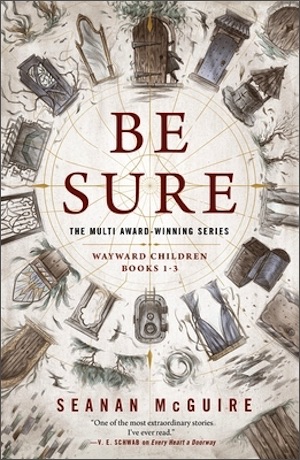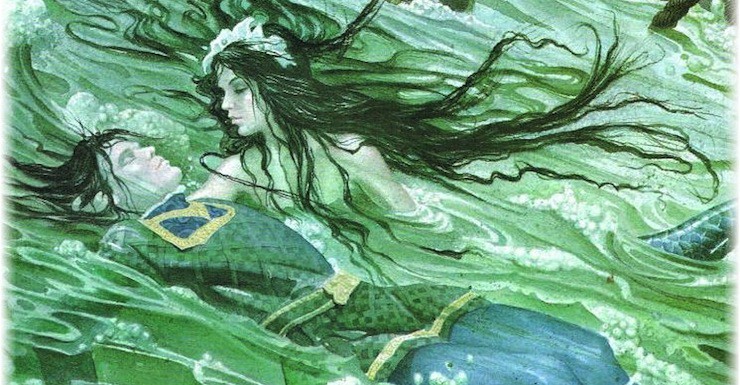Hans Christian Andersen’s earliest years were marked by extreme poverty. His parents did not live together until nine months after his birth, leading Andersen and others to wonder if his father of record—also named Hans Andersen, a shoemaker—was indeed his father. Highly dubious legends later insisted that Andersen was the illegitimate scion of noble, even royal blood, but if so, noble and royal money was distinctly absent in those early years. His maternal grandmother died in a poorhouse, as did his mother. His (probable) paternal grandfather became mentally ill later in life, and also landed in a poorhouse, leaving his wife and children in desperate financial straits. A cousin landed in jail for begging.
What saved Andersen’s soul, then and later, were fairy tales about magical things like little mermaids.
Andersen probably first heard traditional folk tales from his grandmother and other relatives, tales he later worked into his own fiction. Despite the family poverty, the young Andersen also managed to attend, if irregularly, two infant schools and the town’s charity school, which gave him the ability to read a book that transformed his imagination: The Arabian Nights. He also discovered the theatre, another source of magic. When he was fourteen, he travelled to Copenhagen to work in a theatre there, a job that brought him the opportunity for more schooling and exposure to more books. Slowly, he became a writer and creator of new fairy tales.
His initial fairy tales tended to stay close to their oral roots, but gradually, Andersen began to add his own elements to his tales, creating stories that combined elements of folklore, romance, angst, social commentary, angst, delicate magical details, and, for a change, angst. His first volume of fairy tales, which initially appeared as a series of three thin booklets between 1835 and 1837, included a mix of retold folktales and original work, including “The Little Mermaid,” which was first translated into English in 1872.
Andersen had undoubtedly heard legends of mermaids and selkies and sirens and other creatures of the water. The stories date well back into ancient times, and European interest in mermaids had recently resurged thanks in part Frederick de la Motte Fouque’s worldwide bestseller Undine (1811), the tragic story of a water spirit and a knight. Andersen certainly knew the book; he may also have known the E.T.A. Hoffman opera based on the book, first performed in 1814. It reminded him that not all fairy tales need to have a happy ending, and that the quest for a soul can be a dangerous one.
“The Little Mermaid” opens happily enough, with a rich description of the underwater palace of the Sea King. Andersen, unlike other fantasy writers who told stories of similar underwater kingdoms, makes no attempt here for any oceanographic accuracy: his intent here is to build fantasy, and so the palace windows, for example, are made of amber, not exactly a sea product—although later, the little mermaid has to pass through what sounds suspiciously like fire coral, very definitely a marine product, to reach the sea witch.
The little mermaid is the youngest of six sisters, eagerly waiting her chance to head up to the surface of the water where she’ll be able to see humans and other surface wonders as well. The minute she does, things go wrong: she sees glorious fireworks and a handsome prince, but the ship she sees is almost immediately wrecked, with no survivors other than the prince, who only lives because the little mermaid drags him to the shore.
That’s the first hint that the story will not go well. The little mermaid becomes obsessed with the prince—she kissed him a few times in the water—and starts following him as much as she can, and collecting information about him. From this, she learns he’s a good guy—I have my doubts about this, but let’s move on for now—and decides to become human, so she can be with him. The sea witch she consults counsels her against this, since if it doesn’t work out, the mermaid will die, but the mermaid is determined: she gives up her voice, and heads to the surface, to walk on legs that cut like knives at every step.
Once on the surface, the prince dresses her up as a pageboy, and occasionally kisses her passionately on the forehead and says that he might—he might—just marry her. And then he marries someone else—the girl he thinks saved his life, who is also very beautiful, and, I might note, not dressed up as a pageboy, and who does not ask any pointed questions about the beautiful voiceless girl who has been sleeping at the prince’s door on a velvet cushion. Prince, I feel we need to talk about a few things, including the sleeping arrangements you’ve made for little voiceless foundling girls that you occasionally kiss on the forehead, but we may not have that kind of time.
Fortunately for the little mermaid, she’s caught not only in an tragic romance, but also in a Christian redemption story, and so, when she dies, she’s not quite dead yet: she has a chance, perhaps, to earn an immortal soul after all if she’s willing to wait three hundred years with other air spirits. Maybe:
….for every day on which we find a good child, who is the joy of his parents and deserves their love, our time of probation is shortened. The child does not know, when we fly through the room, that we smile with joy at his good conduct, for we can count one year less of our three hundred years. But when we see a naughty or wicked child, we shed tears of sorry, and for every tear a day is added to our time of trial!
Like, THANKS FOR THE GUILT TRIP THERE, AND LETTING ME KNOW THAT EVERY TIME I SCREWED UP AS A LITTLE KID, I HURT A DEAD MERMAID, HANS CHRISTIAN ANDERSEN. I FEEL GREAT NOW.
Anyway.
Despite the focus on earning a soul, and redemption, and the pain involved in both, this is not just a story about love and eternal salvation, but also about social class, and unfairness. I think it’s significant that the little mermaid is not motivated just by her love for the prince, but also by her grandmother’s explanation of the differences between mermaids and humans. Mermaids get to live for 300 years—long by human standards—but when they die, they die, becoming only sea foam on the water. Humans have much shorter lives, but get to continue into immortality. The little mermaid wants love, yes, but she also wants that immortality, and feels that anything—even another 300 years of working as an air spirit—is worth it.
Buy the Book


Be Sure
But the process of gaining that immortal salvation is deeply unfair. It’s not just that in her first try, the mermaid has to give up her voice, her home and her family, and experience torture in every step, but that the humans don’t need to do any of this. Indeed, if a little kid messes up, it’s a dead mermaid’s soul that suffers, not the kid. It reflects a certain social divide that Andersen had witnessed, as he used his skills as a writer to climb from poverty to making regular appearances at the Danish court. The upper classes he interacted with had advantages he never had as a child, and although he later received a tax free stipend from the royal court, he never forgot those early differences.
But I can’t entirely blame social inequities and class divisions for the eventual separation of the prince and the little mermaid. Here, something else seems to be going on, namely Andersen’s own difficulty in forming long term romantic relationships. He was, by his own account, shy with women, and by the accounts of others, not always good at picking up basic social clues. He was also bisexual, in an age where this presented, to put it mildly, difficulties. Despite this attraction to both genders, and long held passionate feelings for specific individuals, it is highly possible that he never had an intimate physical relationship with anyone of either gender. This tends to be reflected in many of his tales, which do not always end with the happy marriage of most 19th century fairy tales. In this, he is perhaps closer to the early French salon fairy tale writers—many of whom were also unhappy in love, who often wrote unhappy endings, and who also often used fairy tales to critique their contemporary society.
Not that everything in “The Little Mermaid” is serious, or tragic, or depressing. Part of the magic of the story is the various throwaway moments here and there. My favorite might be the one where the sea witch announces that cleanliness is a good thing—right before scouring her cauldron out with snakes. I think she and I may have different ideas of what “cleanliness” means. But Andersen has other great moments—including a nice knock at the idea of enduring pain for fashion and status, as the little mermaid complains that the oysters set in her tail, partly to make her look beautiful, but mostly to emphasize her importance, hurt. Hmm. Maybe she had another reason for wanting to escape to the surface and mingle with humans. At the very least the oysters were probably good training for the painful walking she had to do later.
It’s probably that mix of charm, imaginative detail and sorrow that has allowed “The Little Mermaid” to endure as one of Andersen’s most popular and famous tales, translated into at least 150 languages, and retold in various media—opera, ballet, prose and poetry retellings, and at least one animated feature.
In 1913, it also became the basis for a Copenhagen tourist attraction, when a small bronze statue of the protagonist gazing wistfully at mortal lands was unveiled in to honor the tale. The statue soon became a target for vandals (I can personally testify that in its current location, it’s not hard to reach); the current one is a replica of the damaged original. But the vandals did nothing to end the statue’s popularity; tourists happily stood in line to take pictures (I can also personally testify to the lines), and more replicas (authorized and unauthorized), popped up in various cities around the world, in a nice reflection of the enduring nature of Hans Christian Andersen’s original tale.
Originally published December 2015.
Mari Ness lives in central Florida.










